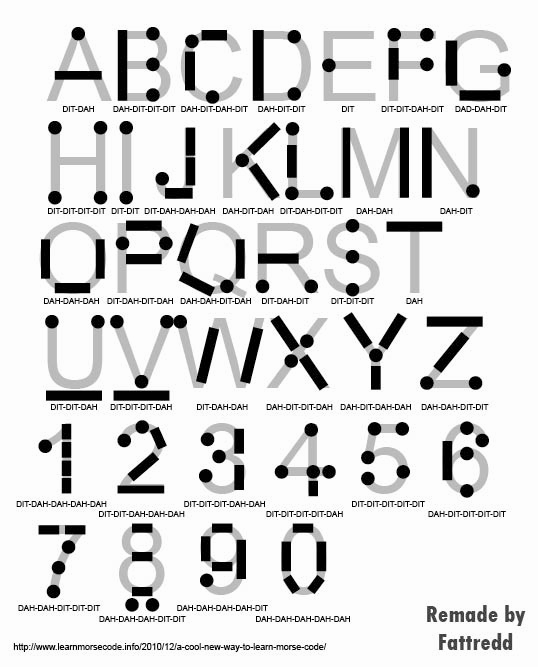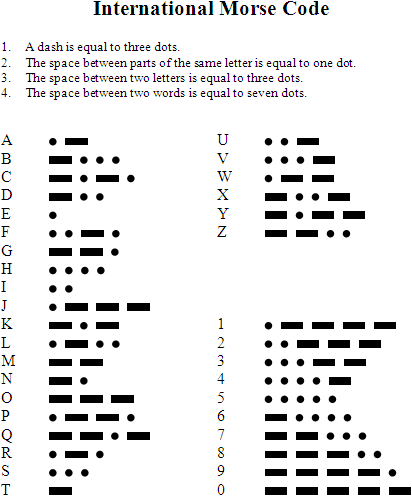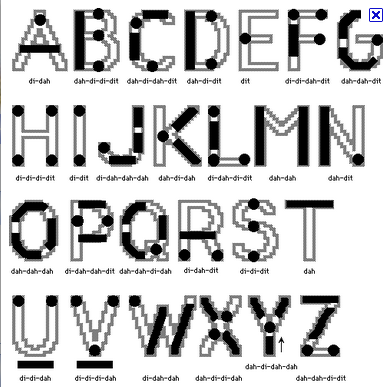Learning Morse Code is just like learning a new brand new language and as such needs a plan of attack and practice. Here are some ideas:
Morse Code Tip #1: Slow and Steady Wins the Race
Begin to learn Morse Code by starting out with the easiest and simplest letters in the alphabet.
Some of the easiest letters are:
- E (. or dit)
- T (- or dah)
- M (– 0r dah dah)
- I (.. or dit dit)
These Morse Code letters are the only letters in Morse Code that use one or two dits and dahs and do not combine the dits and dahs.
From there, the next easiest step is to move onto the simple dit and dah combinations, those using only 2 or 3 dits and dahs.
Here are the next Morse Code letters to learn:
- A (.- or dit dah)
- D (-.. or dah dit dit)
- G (–. or dah dah dit)
- (H) (…. or dit dit dit dit)
- K (-.- or dah dit dah)
- N (-. or dah dit)
- O (dah dah dah)
- R (.-. or dit dah dit)
- S (… or dit dit dit dit)
- U (..- or dit dit dah)
- W (.– or dit dah dah)
Finally, ending with the more difficult letters like “C”, “L”, “Q”, and “X”, that combine 4 dits and dahs in no particular “order”.
Here are the more difficult Morse Code letters:
- B (-… or dah dit dit dit)
- C (-.-. or dah dit dah dit)
- J (.— or dit dah dah dah)
- L (.-.. or dit dah dit dit)
- F (..-. or dit dit dah dit)
- Q (–.- or dah dah dit dah)
- P (.–. dit dah dah dit)
- V (…- or dit dit dit dah)
- X (-..- or dah dit dit dah)
- Y (-.– or dah dit dah dah)
- Z (–.. or dah dah dit dit)
Morse Code Tip #2: If at all possible, try to avoid visualization.
- Your ears hear the code
- Your mind says, “Hey, that’s Morse Code!”
- Your brain tries to bring up an IMAGE of the Morse Code letter or number you’ve heard
- Your brain tries to match the IMAGE to the SOUND
- Finally, you decide on a sound, or you miss the letter, and try to go on to the next letter
Morse Code Tip #3: Listen to Morse Code as often as you can.
Thanks to modern technology, you can find recordings of Morse Code just about anywhere – and you can find versions that are played back slower than what would be considered “normal” conversation.
Take advantage of these options to listen to More Code and use these recordings and videos as tools to test your learning progress.
This is especially important for learning the timing and spacing between letters and between words, as well as being able to instantly and effortlessly tell the difference between a dit and dah length of time.
Morse Code Tip #4: Use Your Own Voice!
Like most languages, Morse Code is both a written and auditory language. To prepare for listening to and translating dits and dahs, many people find it helpful to use their own voices to sound out letters and sentences as they practice.
Another way of incorporating the learners voice is to translate a short story, children’s book, or paragraph while recording. This is a great way of creating a simple test that can be “graded” without any outside assistance later.
Morse Code Tip #5: Have Fun!
As with learning anything, the more personal, entertaining, and a part of everyday life the new skill becomes, the quicker it is learned and the better it “sticks”. This can easily be applied to Morse Code. Emails, texting, grocery lists, notes to loved ones, and journaling are all great options for incorporating Morse Code into everyday life for a little bit of fun practicing as well as getting others around you interested in a new hobby as well!
Morse Code will be Easier with a Morse Code Project Kit!
Wow, we just got our new kit in the mail – and we love it!
Our new Morse Code kit was super easy to build and fun to use – perfect for people who want to learn how to send and receive Morse Code.
Learn Morse Code in only 6 Steps
New Software to Help You Learn Morse Code
Interestingly enough, I’ve just come across some great software to help learn Morse Code. I tried this software out, and it seems pretty good!
While everything is going on in Egypt right now, the question arises – are Egyptians turning to Morse Code to communicate with the outside world? I have been trying to do some research, and it seems like people are constantly talking about Egyptians and Morse Code and Egypt using Ham Radio, but I can’t find anything to support that. I was on my Ham Radio last night, and I did hear a TON of activity on 40 meters, but I’m not sure if it was just a contest or what.
With that said – even if Egypt has not turned to Morse Code to communicate with each other or the outside world, the question arises – what would you do if our government were to shut down all communication methods?
You’d better believe I’d turn on my Ham radio and start pounding out some Morse Code to my fellow Hams!
Alright, alright, enough about me and my love for Morse Code – here’s the link to download the software I found to learn Morse Code. If you do like it, let me know.
A Cool New Way to Learn Morse Code
Wow, I found this cool new way to learn Morse Code. I’m not sure what it’s called, and I wish it was around when I learned Morse Code, but it’s pretty awesome.
Basically, Morse Code can be learned pretty easily visually. Once you have the visual Morse Code learned pretty well, you then need to start LISTENING for Morse Code. (You can look on the products section of this website to find kits and the such to help you learn to listen to Morse Code…)
I learned Morse Code out of an encyclopedia. It took me only about 2 hours of actual memorization. We used to pass noted in grade school written in Morse Code, and the coding/decoding also helped me to learn and retain it.
Anyways, back to the cool new way of learning Morse Code – check out this image:
If you memorize each letter individually, and then think back to it later, it’ll be somewhat easier to learn Morse Code. The only problem is timing – for instance, look at the Y. Y in Morse Code is “-.–” which is said, “dah-dit-dah-dah.” It’s tough to see in the picture above that the Morse Code Y should be that way, but at least you know that there are three lines and one dash, or three dah’s and one dit.
Does that make sense?
Morse Code – I Am Alive!
Here’s how to say, “I am alive” in Morse Code.
.. / .- –– / .- .-.. .. …- . /



